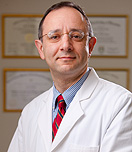News
System screens patients for sleep apnea
-
 Print
Print -
 Comments
Comments
-

“The importance of this grant is that it may give us a faster way to screen for sleep apnea in patients who are already at high risk but who are undiagnosed.”
A new computer screening tool developed and patented by a UB physician is helping to detect severe obstructive sleep apnea in cardiovascular patients who have not yet been diagnosed with this common and potentially dangerous condition.
The study, funded by the U.S. Department of Veterans Affairs, is being conducted by a UB researcher at the Veterans Affairs Western New York Healthcare System.
The goal is to evaluate how well the computer screening tool developed at UB diagnoses sleep apnea in patients with heart disease, compared to an overnight sleep study, or polysomnography, considered the ‘gold standard’ for diagnosing sleep apnea.
“The importance of this grant is that it may give us a faster way to screen for sleep apnea in patients who are already at high risk but who are undiagnosed,” says principal investigator Ali A. El Solh, professor of medicine, School of Medicine and Biomedical Sciences, and professor of social and preventive medicine, School of Public Health and Health Professions.
It is estimated that between 30 percent and 50 percent of cardiovascular patients also suffer from obstructive sleep apnea, many of whom are undiagnosed.
Obstructive sleep apnea prevents sufficient air from getting into the lungs during sleep, causing oxygen levels in the blood to drop. Because it causes numerous interruptions in their sleep, people with sleep apnea are at higher risk for car crashes, work-related accidents and other medical problems, including complications after surgery. Since sleep apnea episodes also can trigger such cardiovascular events as heart attacks, atrial fibrillation and stroke, patients with heart disease who also suffer from sleep apnea are at even higher risk.
“Previous data have shown that patients with heart disease have a high occurrence of sleep apnea and it often goes undiagnosed,” says El Solh. “It makes sense for us to try and screen them for sleep apnea as early as possible so that if they are diagnosed with sleep apnea, we can start treating them before they suffer another event.”
The computer screening tool developed by El Solh and Brydon J. Grant, professor emeritus of medicine, diagnoses sleep apnea based on a patient’s answers to questions concerning anthropomorphic and clinical characteristics, such as body mass index, neck size and the presence of hypertension.
If the neural network-based screening tool proves to be as accurate as polysomnography, then El Solh says it may provide clinicians with a much faster, more accessible way to identify sleep apnea, especially in high-risk patients.
The study will end in December and data analysis should be complete early next year.

Reader Comments